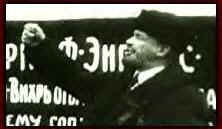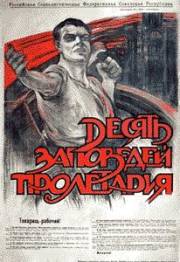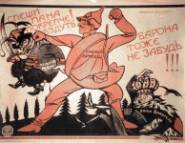|
|
|
|
Summary In November 1917 the Bolsheviks set up an extreme Communist state. It implemented Communist principles, but it also brought in a 'dictatorship of the proletariat', where terror was used to force people to live like Communists. The Bolsheviks needed to establish firm rule because their control of Russia was threatened by a Civil War.
Source AOn November 7 (October 25 according to the Old Calendar) 1917, a new new page was opened in the book of world history. It was written by the revolutionary workers, peasants and soldiers of Russia who proclaimed the country a Republic of Soviets. It marked the beginning of a new era ... In 1917 the peoples of our country began the building of a new society, the first of its kind. Novosti Press Agency Publishing House, What is the Soviet Union? (1980) A propaganda booklet sent free to British teachers at the height of the Cold War. It claimed: '"Information for Peace and International Friendship" is the motto of the Novosti Press Agency'
Source BIn November 1917 a group of people called Bolsheviks, led by Lenin, overthrew the government. They said that they were doing it for the proletariat (or working class) ... However, in spite of all the seemingly good things that Lenin introduced there is much for which he and the Bolsheviks have been criticised... Most decisions were taken by a small group of men called the Politburo. Lenin refused to negotiate with the soviets, who were the elected representatives of the workers and in whose name the Bolsheviks had come to power. Remember the slogan he used - All power to the soviets? L Hartley, The Russian Revolution (1980) A British school textbook published at the height of the Cold War.
|
Going DeeperThe following links will help you widen your knowledge: Old Bitesize - simple intro (pdf) Lenin's Russia - notes (pdf) Brest Litovsk and its interpretations
YouTube Bolshevik Russia - History File
Old textbook account of the Bolshevik State Reed Brett, European History (1967)
|
What kind of state did Lenin set up 1917–1921?[Great Big Changes Create Terrible War]When the Bolsheviks came to power in October/November 1917, they faced exactly the same challenges that had toppled the Tsar and the Provisional Government: a collapsed economy facing shortages of everything, along with high inflation; a war they were losing badly; massive inequality, poverty and illiteracy; mutinous armed forces, a striking workforce, a rioting peasantry, and an intelligentsia seething with resentment. So how did the Bolsheviks survive, where the Tsar and the Provisional Government had failed? In the first nine months following the October/November revolution, the Bolsheviks passed more than 950 decrees and laws, completely remaking Russia into a Bolshevik country.
1. Government changesElections were held in November 1917 for a new government – the Assembly. The Bolsheviks won 175 seats and the Social Revolutionaries won 370 seats. When it met in 1918, Lenin used the Red Guards to close it, and killed anybody who objected. The existing bourgeois state was completely dismantled – Duma, Ministries, courts, armed forces – and a new system of government created. The power of the Soviets of Workers’, Soldiers’ and Peasants’ Deputies was confirmed, with supreme power given to the elected deputies in the All-Russia Congress of Soviets. A Council of People’s Commissars was set up, with Lenin in charge, and new ministries ('People’s Commissariats') were created. This was confirmed in the Declaration Of Rights Of The Working And Exploited People in January 1918, which recognized the 'dictatorship of the proletariat' as the ruling class of the Russian Soviet Republic, the world's first socialist state. = change from autocratic government to 'dictatorship of the proletariat' (i.e. the Communist Party)
2. Brest-LitovskOne of the Bolsheviks' first acts was to pass the Decree on Peace calling for an end to the war with Germany (1917). The Treaty of Brest-Litovsk gave much of Russia’s best agricultural and industrial land to Germany – Ukraine, Estonia, Latvia, Lithuania. = peace not war
3. Communist economyThe Bolsheviks:
= peasants owned their land & workers owned their factories.
4. Communist societyLenin tried to make Russian society communist:
= a different morality and style of life.
5. TerrorThe Bolsheviks created a totalitarian state:
= terror/ no political freedom
6. 'War Communism'The Bolsheviks’ enemies tried to destroy the government, so in 1918-1921 the new government had to fight a Civil War. During the war, especially severe rules were introduced, which are (unhelpfully) called ‘War Communism’ in your textbooks. These measures included:
= a very harsh tyranny.
Source EThe Bolsheviks had found out by experience what they meant by ‘dictatorship of the proletariat’. It was not a collective class dictatorship exercised by workers... It was a dictatorship run by full-time ‘cadres’ or bosses. Sheila Fitzpatrick, The Russian Revolution (1982).
|
Source C
Bolshevik artists produced 3,600 propaganda posters in three years - this poster lists the Ten Commandments of the Proletarian (full list here), urging people to fight for Communist principles.
Source D
This Bolshevik poster reads: ‘Beat up the noblemen – and don’t forget the lords.’
Consider:1. Compare Sources A amd B. How do they differ? Which interpretation do you think is the more accurate? 2. Identify the policies/actions which in your opinion most helped the Bolshevik Government to survive. Explain your suggestions.
3. How did life change for Russian people after 1917, including:
4. Traditionalist historians argued that these Bolshevik rules were simply an excuse to take dictatorial control of the people. Revisionist historians believe that the Bolsheviks genuinely wanted to create a new, idealistic socialist society. What do you think - explain why you hold that view.
|
|
| |



